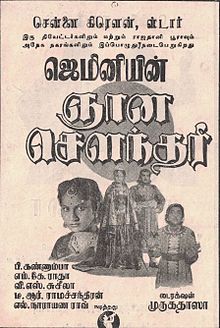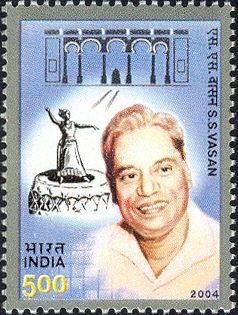An insignificant actor in a 1936 Tamil movie, playing an insignificant role (of a corrupt policeman) would later become a demi-god to millions of fans. The American director of the movie would become a much sought-after filmmaker. But all that was to come much later. ‘If’ the movie was destined to be completed at all. Halfway through the making of Sathi Leelavathi, another media house went to court and asked for a stay order on the film, because they had started making a film with a similar narrative as well.
Marudachalam Chettiar, the producer, panicked and scampered to the novelist who had provided the story in the first place. The writer appeared in court and flaunted an English novel Danesbury House and advanced a bewildering testimony. “I filched the screenplay from this novel. So must have the aggrieved party.” Case dismissed.
The movie was a hit. MG Ramachandran and Ellis Dungan had scripted their itinerary to renown. The novelist too would enter the cinema talkie world a few years later and carve his own niche and end up as a much-feared movie mogul. This was SS Vasan. To Vasan, plagiarism was creativity. His team would later even lift storylines from movies running in theatres.
At that point, though Vasan ran a movie distribution company he was not really keen on cinema production. To him, celluloid was just another commodity. To be bought and sold. He just wasn’t ready to take the rough and rocky road of production in a decade-old Tamil talkies field. His magazine Ananda Vikatan and a flourishing mail-order business (that he established as a student) were keeping his hands full.
As an immigrant arriving in the post-war Madras city of the 1920s, Vasan found the place tailored to suit his entrepreneurial spirit. Nowhere else could a man with absolutely no capital, other than a lofty resolve, make it big.
But when director K Subramaniam’s studio, on Mount Road, burnt down with the negatives of the last movie shot, in 1940, Vasan had to step in, buy the studio and bail him out. The odd bid of Rs.86,427-11-9- led to speculations of numerology, but it was to cover the salary arrears of the studio’s staff. Down to the last paisa.
And then started the ‘Gemini’ saga. Vasan brought his ‘think big’ philosophy to the field, and his logo of the Gemini twins blowing bugles assured cinema watchers that they were in for three hours of rock-solid entertainment. Audiences watched his extravaganzas, their eyes wide open, with astonishment, as ordinary stories turned larger-than-life under his watch. To his credit, Vasan’s mind was persistently preoccupied with thoughts of total entertainment for the audience.
Many satisfactory rival films which had the misfortune of being released alongside a Gemini talkie paled into insignificant ‘also-rans’. And Vasan became ‘The Boss’. That’s what an American editor working for Gemini called him. The name stuck.
The government imposed a length restriction on cinemas due to wartime film scarcity. A particularly maddening decade, the 1940s was when the world war and its scarcities cast their shadows upon our land. Yet, Vasan went on and produced some excellent films and these Gemini movies shook the audiences out of the war era’s morbid mood swings.
Vasan worked as if he were a man possessed. S Radhakrishnan who lived across the road from the filmmaker, after seeing the headlights of the boss’s car turning into the driveway at three past midnight wondered aloud to Vasan’s assistant, “Doesn’t your boss ever sleep?” In fact, the canteen at Gemini Studios ran 24 hours and only workaholics could survive with Vasan.
***
Chandralekha was undoubtedly Gemini’s most iconic film. When SS Vasan tossed out an advertisement to announce the movie, people thought he already had everything–story, script, cast, and even props. But he didn’t even have a story. Just the title. Gemini Studios’ brainstorming team took five years, rehashed a penny dreadful American novel and managed to squeeze a desi story out of it.
Vasan decided, halfway, to include circus scenes to make the proceedings livelier. Two circuses shut shop and moved into Gemini Studios with one renaming itself Gemini Circus after this filmy experience. Horses, elephants, lions, and tigers were all over the sets. Nights in Mount Road were never the same again with roars and trumpeting heard at ungodly hours.
Gemini also ventured into the all-India market and shot many Hindi films right here in Madras. Insaniyat was halfway through with two towering heroes and the charming Beena Roy as the heroine. Even so, Vasan felt his film lacked tempo. (Writer Ashokamitran would say Vasan could add tempo to a railway timetable if he wanted to).
Vasan, never one to reign in his imagination, late into the shooting schedule, changed the script and regardless of consequences to the already shot film added a chimpanzee to the storyline. The heroes Dilip Kumar and Dev Anand failed to comprehend any tangible motive but Vasan had no doubt about how favourably a monkey compared with the cinematic idols of the day. Crowds thronged to see the chimpanzee. Though Dev Anand would later say, “That’s a movie I’d rather forget”.
Vasan never spared an expense if it could make even one scene better. In Avvaiyar, a lone elephant was to answer the poetess’ prayer to Lord Ganesha. It was to turn up outside a fort and knock its door down. Just then the team at Gemini Studios informed Vasan that a herd of captured elephants was being transported from Coorg to Andamans via the Madras port. Vasan changed the script, bulldozed the shipping agent into submission and waylaid the pachyderms, leading them on a procession on Mount Road to his studios.
Now Vasan had a huge herd of elephants (with their broad foreheads painted with holy white lines) and the ‘breaking the fort’ scene was shot over ten days. The elephants with their ‘vibhuthi’ signs were taken directly to the port, lifted by cranes, and loaded onto trawlers just as the starting hoot was heard.
Vasan’s hard work mostly paid off. And the social impact of Gemini’s movies were towering. Just one word in a song in the movie Miss Malini revived the fortunes of a much forgotten ‘Veerapandiya Kattabomman’ making him the superstar among all freedom fighters. A huge chunk of the population had not even heard of the martyr till then.
Just as he never hesitated to spend, Vasan was not one to mince words either. And he wasn’t right all the time. His goof ups are all Kollywood folklore. Once his frown deepened when an assistant director brought in a stage actor for a role in Chandralekha–he was ok with even one of the hundreds of soldier roles that the film required. While denying the actor that role, Vasan did not even try to give the trembling actor a humane brush-off. He also offered advice (which would embarrass him the most, later) that the actor was suited only for stage and would ruin his life in cinema. Less than a decade later Vasan would eat humble pie seeing the meteoric rise of that actor. Sivaji Ganesan. There was always some coldness between the two though they made two movies together.
***
Writers with stupendous intellect, including RK Narayan, Kalki, Devan, and Kothamangalam Subbu have written for Vasan’s movies and magazine. He had a knack of getting the best out of their pens but it is anyone’s guess if he ever left their scripts untouched by his interference.
A moment of supreme embarrassment in his career was the film Gnanasoundari. Vasan was squarely deceived by it at the outset. Gemini had the audacity to shoot a movie–a rehash of one running just then in the theatres. And it was a Christian storyline with Mother Mary and Jesus Christ appearing on screen to save a princess whose hands had been amputated by an evil stepmother. The script of the movie was written in what Gemini Studios specialised in–the ‘Tambram’ slang of Mylapore’s bylanes.
The audience was rather soured and made its wrath known with a spot of violence. Spectators tore theatre screens and broke its chairs. That Vasan had made a mistake was evident for all to see. While most of his men ascribed it to a trivial slip up due to inherent cultural differences, Vasan did not do so. He had a lesson to learn from every gaffe.

IMG-20190826-WA0003
Vasan did not attribute the reaction to Gnanasoundari to any malice or stupidity on the part of the viewers. He knew his creative team was no longer in tune with the pulse of the public. When Vasan realised he had condemned a movie to the dustbin because of the ‘Tambram’ slang, he did some lateral thinking. A few years later, Vasan commissioned a novel in Ananda Vikadan with no brahminical influence at all–and then came Thillana Mohanambal about the Isai Vellalar community with only the villain being a bramhin. The novel and the ensuing movie were great hits.
***
Gemini Studios worked on a prevailing system of contracts where actors (often stars) with salaries, stood in attention when the boss walked by. While Vasan assured them of continuous work, they could not act or direct for other studios. (The superstars of the 40s Thyagaraja Bagavathar and PU Chinnappa kept away from Gemini.)
Recommended
With the onset of new age superstars like Sivaji and MGR in the 1950s, things changed. Star value overtook studio value. Studios that didn’t know how to handle superstars fell swiftly. Movies began with title cards that read “Sivaji Ganesan Presents” or “MG Ramachandran Presents”. (A milkman became the biggest producer in Tamil cinema because he got the call sheets of 17 successive MGR movies.)
Gemini films had become a relic of the old days and a final trade union strike crippled it. Ananda Vikatan (though Vasan would not recognize it today off a bookshelf) has survived the decades by changing with the times.
For all his authority, the boss moved around in his simple garb (a dhoti, a shirt, and slippers like an average south Indian on the street). He was a simple man who cared for people. During World War with a fast emptying city and locked eateries, Gemini was one of the very few employers who used to give subsidised food and parcels to take home for dinner. The Gemini Studios had sufficient private means to enable them to indulge these whims.
Vasan also took a personal interest in the lives of those who worked for him. To bring about a reconciliation between estranged mother and daughter duo Vasundara and Vyjanthimala, he made them on-screen mother and daughter in the trade unionist movie Irumbu Thirai.

Vasan has left an indelible mark in our cinema-scape. Even today, most remember with fondness, the Gemini twins blowing the bugle. It is supposed poetically that the history of the world is but a biography of great men. The history of Tamil cinema is too.
Venkatesh Ramakrishnan is a bilingual novelist and historian. He is the author of ‘Kaviri Maindan’ the sequel to Kalki’s ‘Ponniyin Selvan’ and a novel on Delhi Sultanate’s invasion of South India called ‘Gods, Kings and Slaves’. He specialises in the history of Madras city.



